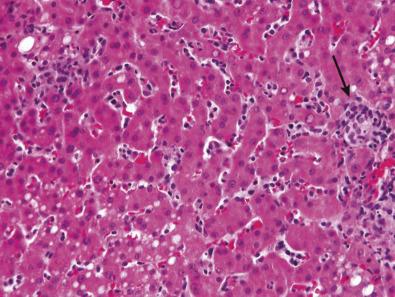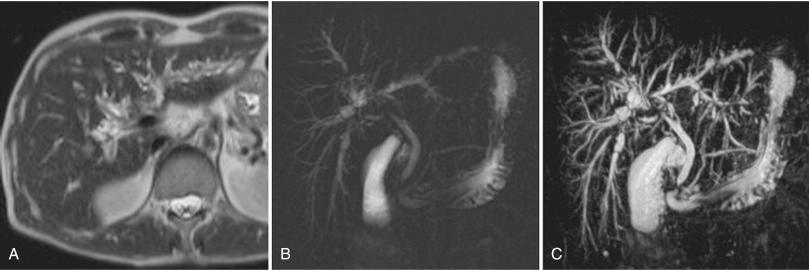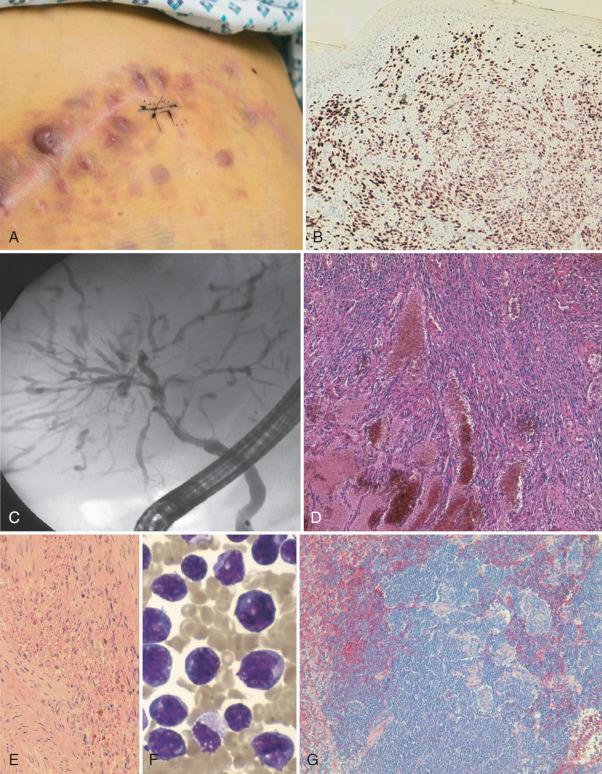Physical Address
304 North Cardinal St.
Dorchester Center, MA 02124
acquired immunodeficiency syndrome
alanine aminotransferase
aspartate aminotransferase
cytomegalovirus
dengue hemorrhagic fever
dengue shock syndrome
Epstein-Barr virus
enzyme-linked immunosorbent assay
highly active antiretroviral therapy
human herpesvirus
human immunodeficiency virus
herpes simplex virus
immunoglobulin G
immunoglobulin M
posttransplant lymphoproliferative disease
reverse transcription polymerase chain reaction
severe acute respiratory syndrome
varicella-zoster virus
The liver can be affected as part of a generalized host infection with viruses that primarily target other tissues. Liver involvement in nonhepatotropic viral infections can range from mild derangement of liver biochemistry to fulminant liver failure. In most of these infections, liver inflammation is thought to be a consequence of an immune response to viral antigens rather than a direct hepatic infection. In this chapter we review liver diseases associated with opportunistic viral infections in immunocompromised hosts, common systemic viral infections, and viral hemorrhagic fevers.
Epstein-Barr virus (EBV) is transmitted by contact with oral secretions and resides latently in the resting memory B cells. Primary EBV infection affects 90% of the population and manifests as the classic triad of fever, sore throat, and lymphadenopathy, known as infectious mononucleosis . Gastrointestinal manifestations such as abdominal pain, nausea, and diarrhea are mild. EBV often causes a mild self-limited hepatitis, manifested as twofold to threefold elevations of the levels of serum aminotransferases and hepatosplenomegaly. A cholestatic biochemical pattern has been described in up to 65% of cases but jaundice is rare (5% to 10 % of cases) and vanishing bile duct syndrome is sporadic. Severe hepatitis or acute liver failure requiring emergent liver transplantation is very rare (0.21% of acute liver failure cases in the United States) but has a high case-fatality rate. Notably, these patients are young (younger than 30 years) and immunocompetent. Clinically significant hepatic damage from EBV infection can occur in immunosuppressed patients, such as human immunodeficiency virus (HIV)-positive patients, transplant patients, or inflammatory bowel disease patients receiving immunosuppressive medications. Chronic hepatitis potentially linked to EBV infection has been reported. Some cases of autoimmune or granulomatous hepatitis have also been associated with EBV infection. Despite the definite oncogenic potential of EBV, there is no convincing evidence linking EBV and the development of liver cancer, with the exception of the lymphoepithelioma-like hepatocellular carcinoma and lymphoepithelioma-like cholangiocarcinoma. EBV infection after liver transplantation is a rare (3%) but feared complication because it can lead to posttransplant lymphoproliferative disease (PTLD). Because 90% of adults are EBV seropositive, the predominant pathophysiologic mechanism of active EBV infection after transplant is EBV reactivation. High-dose steroid treatment of rejection is a strong predictor of PTLD.
| Virus | Manifestations of Primary Infection | Manifestations in Immunocompromised State | Characteristic Features of Liver Disease | Diagnosis | Treatment |
|---|---|---|---|---|---|
| EBV | Fever, sore throat, lymphadenopathy (infectious mononucleosis); self-limited hepatitis | Severe hepatitis; PTLD | Beaded sinusoidal lymphocytic infiltration in a single-file pattern | In situ hybridization and PCR | Supportive; PTLD: reduction of immunosuppression, rituximab |
| CMV | Mononucleosis-like symptoms (10%) | Fever, neutropenia/thrombocytopenia, end-organ disease (hepatitis, pneumonia, retinitis, central nervous system disease); AIDS cholangiopathy | Mononuclear portal and sinusoidal infiltrate | Quantitative PCR assays, histopathology, and CMV-specific immunostaining | Ganciclovir or valganciclovir; reduction in pharmacologic immunosuppression |
| HSV | Oral (HSV 1) or genital (HSV 2) vesicular lesions | Fulminant hepatitis | Hepatocyte necrosis, intranuclear inclusions detected by H&E staining | HSV DNA detected by PCR and histopathology | Acyclovir |
| VZV | Generalized rash (chickenpox) | Hepatitis, cutaneous lesions | Hepatocyte necrosis, intranuclear inclusions detected by H&E staining | PCR and histopathology | Acyclovir |
| HHV 6 and HHV 7 | Roseola infantum (HHV 6); pityriasis rosea (HHV 7) | Fever, hepatitis, pneumonitis, encephalopathy, cytopenia | NA | PCR or shell-vial cultures | Ganciclovir, foscarnet, cidofovir |
| HHV 8 | Fever, lymphadenopathy, rash | Kaposi sarcoma, body cavity lymphoma and multicentric Castleman's disease | Whorls of spindle-shaped cells with leukocytic infiltration and neovascularization with aberrant proliferation of small vessels | Viral DNA in serum or tissue detected by PCR | HAART in HIV infection; reduction of immunosuppressive regimen after transplant or switch of immunosuppression agent to an mTOR inhibitor (sirolimus, everolimus) |
| A denoviruses | Pharyngitis, conjunctivitis | Hepatitis | Circumscribed foci of necrosis in the hepatic lobule with infiltration of monocytes | Immunohistochemical staining or viral culture | Cidofovir |
Although liver biopsy samples from EBV hepatitis patients exhibit a wide spectrum of histologic features, a moderate to marked lymphocytic infiltrate in the portal tracts with scattered foci of interface activity is the main finding. When a large number of atypical lymphocytes are present, exclusion of hepatosplenic T-cell lymphoma should be considered. A more characteristic feature of EBV hepatitis is the beaded sinusoidal lymphocytic infiltration in a single-file pattern ( Fig. 38-1 ). Additionally, a variable degree of bile duct damage can be seen in most cases, although the mechanism is unknown. Small epithelioid granulomas can be seen, which, together with the biliary histopathologic features and biochemical cholestatic pattern can mistakenly lead to a false diagnosis of primary biliary cholangitis. The diagnosis of EBV hepatitis requires a high index of suspicion and confirmation with ancillary tests, such as in situ hybridization and polymerase chain reaction (PCR), which are equally sensitive. Immunohistochemical staining for EBV latent membrane proteins does not have a role in EBV diagnosis.

Because a positive EBV PCR or in situ hybridization of the liver tissue cannot discriminate a relevant EBV infection from occasionally circulating EBV-positive lymphocytes, it is important to interpret these results in the context of histopathologic changes, EBV serologic findings (immunoglobulin M [IgM] and immunoglobulin G [IgG] to viral capsid antigen and Epstein-Barr nuclear antigen) and liver enzyme level alterations.
Treatment of EBV infection is supportive, as the infection self-resolves in 2 to 4 weeks. Corticosteroids and acyclovir do not have a clinical benefit. Liver transplantation in EBV-related acute liver failure is effective. Initial treatment of PTLD consists of reduction of immunosuppression, followed by additional therapies such as anti-CD20 monoclonal antibodies (rituximab) if no response is observed.
Cytomegalovirus (CMV) is a ubiquitous herpesvirus that, depending on the population studied, infects 40% to 100% of humans. Primary CMV infection in immunocompetent individuals presents most commonly as an asymptomatic illness or as a benign infectious mononucleosis-like syndrome in approximately 10% of cases. Subclinical self-limited serum aminotransferase elevation can be present. Rare cases of thrombotic complications, such as portal vein thrombosis and Budd-Chiari syndrome, have been described. Histologic findings are nonspecific and include mononuclear portal and sinusoidal infiltrates, increased hepatocellular mitotic activity, and minimal hepatocellular necrosis. Typical CMV nuclear inclusions and CMV antigen by immunoperoxidase are rare. CMV has been described as a cause of acute granulomatous hepatitis in immunocompetent patients with fever of unknown origin.
When CMV infection occurs in individuals with compromised immunity, such as liver transplant recipients, or individuals with HIV infection or malignancy, it is associated with substantial morbidity and mortality. Infection after liver transplantation is an important entity, as CMV is the most common viral pathogen that influences the outcome of liver transplantation. In these patients, CMV disease manifests as fever, neutropenia/ thrombocytopenia, and commonly end-organ disease, such as pneumonia, retinitis, central nervous system disease, or hepatitis. CMV infection (evidence of CMV replication regardless of symptom presence) and disease (evidence of CMV infection with attributable signs or symptoms) occurring after liver transplantation in high-risk recipients are associated with a significant increased risk of death and graft loss. There is a bidirectional relationship between CMV infection and the risk of allograft rejection.
CMV is an important etiologic agent of acquired immunodeficiency syndrome (AIDS) cholangiopathy, along with Cryptosporidium parvum . The most common cholangiogram findings are distal stenosis of the extrahepatic biliary ducts combined with diffuse irregularity of the intrahepatic bile ducts ( Fig. 38-2 ).

Diagnosis of primary CMV infection in immunocompetent hosts is usually made by serologic studies, either the detection of CMV-specific immunoglobulin (IgM) or a fourfold rise in the level of CMV-specific IgG. Serologic tests have no role in diagnosing CMV disease in immunocompromised patients, for which quantitative PCR assays and histopathology and CMV-specific immunostaining of tissue biopsy specimens should be used.
The standard treatment of CMV disease consists of intravenously administered ganciclovir or orally administered valganciclovir, and if feasible, reduction in pharmacologic immunosuppression. Antiviral prophylaxis or preemptive therapy is similarly effective in preventing CMV disease in modest-risk CMV-seropositive liver transplant recipients, whereas antiviral prophylaxis is the preferred strategy over preemptive therapy for the prevention of CMV disease in high-risk recipients (CMV-seronegative recipients of liver allografts from CMV-seropositive donors).
Herpes simplex virus (HSV) infections are common and manifest as characteristic oral (HSV 1) or genital (HSV 2) vesicular lesions, occasionally accompanied by fever and malaise. The virus persists in a latent state in the ganglion neurons and can reactivate during episodes of immunosuppression or stress.
Hepatic involvement is rare but can be associated with 80% mortality. Unlike the smoldering course of CMV infection, HSV hepatitis presents as a fulminant disease that is usually fatal if untreated. It occurs most commonly in immunosuppressed settings, such as after transplant, in malignancies, in HIV infection, and during the neonatal period, but it has also been described in immunocompetent hosts. Clinical manifestations include fever, abdominal pain, leukopenia, and coagulopathy. Typical vesicular lesions occur in 30% of cases; thus the diagnosis should not rely on their presence.
Before the institution of antiviral prophylaxis, HSV hepatitis after solid-organ transplant was noted within 20 days after transplant (earlier than for CMV disease) and was associated with disseminated infection in most of the cases. The serum aminotransferase levels can be elevated 10 to 100 times the normal range. In the absence of timely diagnosis and treatment, the clinical course can rapidly progress to multiorgan failure, disseminated intravascular coagulopathy, and death. The liver appears enlarged and necrotic. Microscopy reveals focal or diffuse hepatocyte necrosis, with characteristic intranuclear inclusions revealed by hematoxylin and eosin staining ( Fig. 38-3 ).
![Fig. 38-3, Herpes simplex virus (HSV) hepatitis. A, Low-power micrograph (hematoxylin and eosin [H&E] stain, ×40) of the needle liver biopsy specimen showing a disruption of the overall architecture with patches of inflammatory cells. B, Higher magnification (H&E stain, ×200) reveals morphologic evidence of severe necrosis and hemorrhage. C, Immunohistochemistry for detection of HSV (×200) demonstrates extensive positive staining of necrotic hepatocytes, diffusely distributed throughout the tissue. D, Immunohistochemistry for detection of HSV (×400) emphasizes high-power magnification of the positive cells with characteristic intranuclear inclusions ( arrows ) seen with HSV. Fig. 38-3, Herpes simplex virus (HSV) hepatitis. A, Low-power micrograph (hematoxylin and eosin [H&E] stain, ×40) of the needle liver biopsy specimen showing a disruption of the overall architecture with patches of inflammatory cells. B, Higher magnification (H&E stain, ×200) reveals morphologic evidence of severe necrosis and hemorrhage. C, Immunohistochemistry for detection of HSV (×200) demonstrates extensive positive staining of necrotic hepatocytes, diffusely distributed throughout the tissue. D, Immunohistochemistry for detection of HSV (×400) emphasizes high-power magnification of the positive cells with characteristic intranuclear inclusions ( arrows ) seen with HSV.](https://storage.googleapis.com/dl.dentistrykey.com/clinical/LiverDiseaseAssociatedWithSystemicViralInfection/2_3s20B9780323375917000380.jpg)
The diagnosis should be established rapidly by measurement of serum HSV DNA by PCR. Serology has a limited role, as IgM presence can be falsely negative early in the disease course or in very ill patients. Liver biopsy should be performed early in the course of the disease.
The role of liver transplantation in fulminant HSV hepatitis is controversial. Removal of the liver as a large HSV reservoir leads to significant decline of the level of viral DNA, but extrahepatic disease in the context of posttransplant immunosuppression can occur despite low or undetectable levels of HSV DNA. Mortality after liver transplantation for HSV-related acute liver failure is 55%. It is unclear if the mortality is attributed to direct viral effects or indirectly to the pretransplant morbidity or underlying disease that predisposed the individual to the initial HSV infection.
Fulminant liver failure secondary to HSV disease is an infectious disease emergency. Because of the potential for rapid progression to death or the need for liver transplantation, empiric acyclovir therapy for patients presenting with acute liver failure of unknown cause is recommended until HSV hepatitis has been excluded. Acyclovir reduces the risk of death or need for liver transplantation by 86% (odds ratio 0.14; 95% confidence interval 0.06 to 0.33). With the routine use of acyclovir for prophylaxis, the incidence of HSV infections after solid-organ transplant has declined significantly. Acyclovir resistance is rare but it has been described in immunocompromised individuals.
Primary varicella-zoster virus (VZV) infection affects approximately one third of the U.S. population and causes varicella (chickenpox), manifested as generalized rash. Persistence of virus in the sensory dorsal root ganglia can lead to reactivation, manifested as a painful vesicular rash in a dermatomal distribution (shingles). The risk of reactivation is higher in immunocompromised patients. Visceral organ involvement is rare but has been documented in immunocompromised patients because of HIV infection or immunosuppressive drugs (chemotherapy after transplant). Cutaneous lesions eventually develop but their appearance may be delayed. Liver histologic features are similar to those in HSV hepatitis. Diagnosis is made by serum VZV PCR. Prompt institution of high-dose intravenously administered acyclovir has improved the prognosis of patients with this disease. Live attenuated vaccines are licensed for prevention of varicella and zoster but are contraindicated in immunosuppressed individuals such as transplant recipients.
Human herpesvirus (HHV) 6 and HHV 7 are ubiquitous lymphotropic viruses with genetic and biologic properties similar to those of CMV. Their effects are mediated by immunomodulatory properties and synergistic effects with other viruses. They are acquired during early childhood by 95% of the population. Most primary infections are subclinical but the disease can manifest as fever and rash. HHV 6 causes roseola infantum. HHV 7 has been associated with pityriasis rosea. The viruses persist in a latent state and reactivate during periods of immunosuppression, such as after organ transplant or during critical illness–related stress.
Similarly to CMV, HHV 6 can cause fulminant hepatitis in neonates and infants as a result of mother-to-child transmission. It may also account for a large number of acute liver failure cases of unclear cause. Timely diagnosis and valganciclovir therapy can potentially avoid the need for liver transplantation. Half of the patients who received a transplant for HHV 6–related fulminant hepatitis showed HHV recurrence after liver transplantation, without long-term impact on graft or patient survival.
The incidence of infection with HHV 6 and HHV 7 after transplant ranges from 32% to 48% and from 46% to 57%, respectively. HHV 6 infections occur typically 2 to 4 weeks after transplant. The clinical manifestations can be divided into direct clinical manifestations, including febrile syndromes, pneumonitis, hepatitis, encephalopathy, and marrow suppression, and indirect effects resulting from the triggering of immunologic phenomena or transactivation of other herpesviruses such as CMV. Hepatitis from HHV 6 and HHV 7 has been described most commonly in liver transplant recipients. The liver test values are elevated in a mixed pattern. HHV 6 may also be associated with liver allograft rejection and increased mortality. HHV 6 has been associated with reactivation of HHV 7, CMV, and invasive fungal infections.
Diagnosis is best established by PCR techniques or shell-vial cultures. Serologic tests are of limited value because of high seroprevalence in the general population, cross-reactivity, and diminished serologic reactivity in immunosuppressed individuals. Treatment includes active antiviral agents as in CMV infection, such as ganciclovir, foscarnet, and cidofovir.
HHV 8 (Kaposi sarcoma–associated herpesvirus) is part of the human gamma herpesviruses, which include EBV, similarly to which it plays an important role in cellular proliferation and the development of malignancies. HHV 8 is the etiologic agent of Kaposi sarcoma, body cavity lymphoma, and multicentric Castleman disease. The exact mode of transmission of HHV 8 remains unclear. Potential modes of transmission include saliva, sexual transmission, blood transfusions, and solid organ transplant. The prevalence of HHV 8 infection in the United States is unclear but recent studies estimate a rate of 30% in blood donors and up to 56% in HIV-seropositive subjects. Kaposi sarcoma is classically associated with AIDS, as it is 300 times more common in AIDS patients than in other immunosuppressed hosts. However, it is increasingly recognized as a complication of solid organ transplant (incidence of 0.4% in the United States), with the highest rates in liver transplant recipients. Kaposi sarcoma represents 5.7% of malignancies after transplant.
Hepatic involvement is not common with primary infection, which typically manifests as a mild febrile illness, lymphadenopathy, and rash. However, liver nodules can be part of the multiorgan involvement of Kaposi sarcoma, or rarely the first manifestation of the disease. The manifestations include characteristic dark-red nodules present on the skin and visceral organs. Whorls of spindle-shaped cells with leukocytic infiltration and neovascularization with aberrant proliferation of small vessels are characteristic microscopic findings ( Fig. 38-4 ).

Castleman disease is a rare lymphoproliferative disorder, which manifests as fever, splenomegaly, hepatomegaly, and massive lymphadenopathy. Primary effusion lymphoma (body cavity lymphoma) is a specific subtype of B-cell lymphoma related to HHV 8, and involves the peritoneal, pleural, and pericardial spaces.
Diagnosis is based on identification of viral DNA in serum or tissue by PCR. In the setting of HIV infection, treatment of HHV 8–related disease consists of immune function restoration with highly active antiretroviral therapy (HAART). In transplant recipients with positive HHV 8 serologic findings or receiving an organ from a donor with positive HHV8 serologic findings, the monitoring of HHV 8 DNA after transplant is strongly recommended. Management of Kaposi sarcoma in these patients consists of reduction of the immunosuppressive regimen or a switch of the immunosuppression agent to an inhibitor of mammalian target of rapamycin such as sirolimus or everolimus. Ganciclovir, foscarnet, and cidofovir are effective in vitro but clinical studies showing benefit of targeted antiviral therapy are limited to valganciclovir. For patients with visceral of Kaposi sarcoma or lymphoma, chemotherapy agents such as doxorubicin, daunorubicin, paclitaxel, or rituximab have been used with some success.
Become a Clinical Tree membership for Full access and enjoy Unlimited articles
If you are a member. Log in here